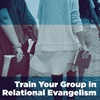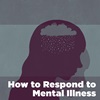Community is a complex creature. Many factors contribute to finding successful community. With the erosion of the geographically close family and the heightened mobility of our culture, many people struggle to learn healthy competencies for community.
Schools, service agencies, churches, and other organizations are making a concerted effort to help. Yet several common myths surround the search to belong, myths that dilute and confuse the definitions we employ to describe our journey to connect.
More time equals more belonging. The first myth is that the greater the amount of time spent in relationship with another person, the more authentic the community will be. This is a pervasive myth. In reality, time has little to do with a person's ability to experience significant belonging. Many people tell stories of first-time, episodic introductions from which a spontaneous connection emerges. Have you ever said, "I just met you, but it seems like I've known you all my life?"
Or, for still another perspective, Rose describes an experience at her church:
About a month ago a woman named Sandra began attending. She is 56 years old. She came to our group last night. She has zero church background. Four years ago she was alone on a week-long vacation to Mexico. One morning by the pool, she struck up a conversation with the young woman sitting next to her. She learned that this young woman was there on her honeymoon. When the bride's husband joined her by the pool, Sandra tried to excuse herself, but they just kept talking with her.
Sandra said that off and on during the rest of her vacation, she ran into this couple. They mentioned they attended a Vineyard church in California. Sandra was quick to mention to me, "It wasn't like they were trying to recruit me or anything; it just came up in one of our conversations that they were Christians and where they went to church."
Sandra was so impressed with how kind they were, and she liked how they treated each other. She went away from them thinking they had something—values or a lifestyle—she found attractive.
She told me probably once a year for the past four years she has thought about going to church. She looked in the phonebook for a Vineyard church (because she had no idea where else to go) and found us.
A short connection around a swimming pool had significance years later. Belonging is not controlled by time, and time by itself does not develop belonging.
More commitment equals more belonging. People often believe that there is a significant relationship between commitment and community. This is, however, a romantic view. When we search to belong, we aren't really looking for commitment. We simply want to connect.
A relationship that involves commitment does not necessarily promote a greater experience of belonging. A married couple may feel very committed to their relationship, yet still feel the strain of "not belonging to each other." Every month I am reminded of my commitment to my financial responsibilities, yet I never experience belonging because of those commitments.
To experience healthy community we need significant relationships. "Significant" is not the same as "close" or "committed." My wife, Sara, practices the ancient craft of rug hooking. "Hookers," as they call themselves, gather around the country in small guilds, in weeklong schools, and for conferences. Every fall Sara attends a weekend conference in northern Ohio. This conference is very significant in Sara's life. She finds help with her craft. She connects with those who have the same passion. Mostly, she finds a respite from her busy life. Yet neither the relationship with the conference nor the relationship with the participants can be accurately called "committed."
Sara is by no means committed to the conference. Every year the discussion is repeated: "Should I spend the money and time or should I stay home?" Even though she has attended several years in a row, the conference cannot count on her commitment. What they can count on is her passion for the craft. And that she will make her decision to attend at the very last moment.
She has no committed relationship with any of the participants. She is just now beginning to remember their names from year to year. She rarely connects with them outside of the conference. She has never called any of them on the phone to chat.
These relationships cannot be described as close or committed. Still, they are significant to Sara's healthy experience of community.
More purpose equals more belonging. During the 1980s Tom Peters led The Search for Excellence revolution within the business community. Mission, vision, and purpose statements were prescribed to ailing and healthy organizations alike. Groups were started to help people with their search for community, and the first order of business was to write a statement of purpose. After all, people who strive together toward a common goal connect, right?
We even changed our language. We no longer asked people to attend committee meetings. They were now part of a team. And this simple change was all in the hope of helping people connect in significant ways.
Although many positive accomplishments sprang from this newly focused approach, in reality this strategy has very little connection with the community experience. Sometimes people who have a common passion and purpose do connect. But a common purpose or vision or goal does not guarantee that people will connect.
More personality equals more belonging. Many people believe that some have a natural ability to belong. They assume that if a person is more gregarious, more extroverted, he or she will have little trouble experiencing community, whereas those who are shy will struggle to belong.
This misconception is based on an outward perception of what is taking place. It has very little to do with what is actually experienced. I have interviewed several extroverts who outwardly seem to have little trouble connecting, yet who speak of a deep search for belonging. I have listened also to those who are shy tell me that their lives are rich and full with significant community.
Introversion and extroversion are learned forms of social behavior that help us navigate our day-to-day lives. They are categories for helping us understand and interpret our relational experiences. But introversion and extroversion neither block nor enhance our experience of belonging. Healthy community can be experienced and developed by introvert and extrovert alike.
More proximity equals more belonging. Remembering a time when the culture was less mobile than it is today, people tend to believe the fifth myth: geographical proximity creates greater community. Says Randy Frazee, "The simple fact is that in all places of effective community people live in close proximity to each other."
This statement is both true and false. It is true that people who live in close geographical proximity may connect with one another. Yet space is in some sense a matter of perspective. The same real estate can convey a certain distance in one situation yet have an entirely different meaning in another.
Further, "close proximity" need not be geographical. Consider, for example, the significant connections that are made digitally. Online bulletin boards and chat rooms, instant messaging, and mobile phone text messaging do not require close proximity to establish significant connections among people.
More small groups equals more belonging. I have often heard ministers say to their congregations, "We're glad you're here. But if you really want to know what it's like to be part of our congregation, participate in a small group."
The implication is that small groups are the best—if not the only—way to build authentic community. Almost every book I read on developing a successful church touts small groups as the key. But I have read that churches that provide small group opportunities can expect about a thirty percent involvement at best from the congregation. Even if thirty percent involvement is higher than it is in churches without small group programs, it is still not good.
Why only thirty percent? It is because small groups do not accomplish the promise of fulfilling all facets of a person's search for community. Small groups deliver on only one or two specific kinds of connection. A person's search for community is more complex than this. The truth is that people can experience belonging in groups ranging in size from 2 to 2,000 or more. People have the competencies to pursue many different paths in their search for community. Many congregations have gone down the small group road only to find they have circled a cul-de-sac and ended up where they began.
Probably, most of us have bought into one or more of these six myths, whether wittingly or unwittingly. And most of us have probably been left feeling like we've been cheated out of a promise. I know I have. These are the myths we must wrestle with as the emerging church struggles with redefining community, neighbor, intimacy, and small group.
Copyright © Joseph R. Myers










